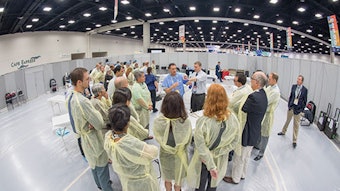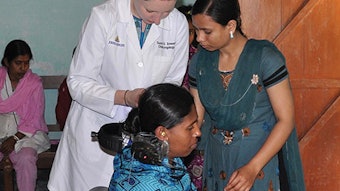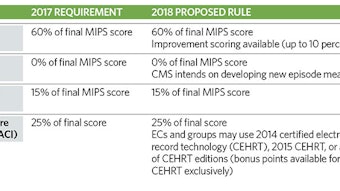OREBM Committee: Early frenotomy may not solve breastfeeding challenges
In this Bulletin segment, our committee shares highlights from recent key research in otolaryngology-head and neck surgery. We offer concise summaries of significant findings that may alter current surgical practice.
Nikhila P. Raol, MD, MPH, with Scott E. Brietzke, MD, MPH, Cuneyt M. Alper, MD, Stacey L. Ishman, MD, MPH, Vikas Mehta, MD and Jennifer J. Shin, MD, SM

Emond A, Ingram J, Johnson D, et al. Randomized controlled trial of early frenotomy in breastfed infants with mild–moderate tongue-tie. Arch Dis Child Fetal Neonatal Ed 2014;99:F189–F195.
This prospective, randomized pragmatic trial compared immediate frenotomy to standard care with lactation support in term infants less than two weeks of age with a mild or moderate degree of ankyloglossia and with mothers who were having difficulties breastfeeding. Prior to this study, the number of studies with quality evidence was limited, and RCTs between 2004 and 2012 demonstrated that frenotomy is an effective procedure in severe cases of ankyloglossia. However, a well-done, sufficiently powered prospective study was needed prior to making a case for or against frenotomy in infants with mild to moderate degrees of ankyloglossia.
Eligible patients were mothers with term babies with ankyloglossia who were experiencing difficulty with breastfeeding, including nipple soreness and trouble with latching. A lactation consultant observed a nursing session and used the Hazelbaker Assessment Tool for Lingual Frenulum Function (HATLFF) and the Latch, Audible swallowing, nipple Type, Comfort, Hold (LATCH) scale to assess feeding and determine eligibility. Babies with a HATLFF score of 6-12 (indicating mild to moderate ankyloglossia) and a LATCH score of ≤8 were deemed eligible.
Mothers and infants were then randomized either to an intervention arm (immediate frenotomy) or a control arm (standard postnatal lactation support). All participants were offered routine breastfeeding support and were seen for assessment five days later.
Mothers in the control arm who were still having difficulty with breastfeeding at that time were offered the frenotomy for their infants. A final assessment at eight weeks was completed by all participants. The primary outcome was the LATCH score at five days. Secondary outcomes were LATCH score at eight weeks, and Infant Breast Feeding Assessment Tool (IBFAT), Breastfeeding Self-Efficacy Score-Short Form (BSES-SF), and pain (using the Visual Analog Scale) at five days and eight weeks. Interviews were also conducted with 20 women for qualitative analysis.
A total of 107 infants were randomized into the study, with 55 in the immediate frenotomy group and 52 in the control group. 53/55 (96 percent) in the intervention group and 52/52 (100 percent) in the control group completed the study. There was no difference in the primary outcome of LATCH score at the five-day mark between the two groups (p=0.52). With regard to the secondary outcomes, there were no differences in the IBFAT score (p=0.36) and pain score (p=0.09) at five days. However, the intervention group had a significant improvement in BSES scores at five days (9 versus 1 point increase, p=0.002). At the time of these intention-to-treat analyses, 9/52 (17 percent) of those infants in the control group had undergone frenectomy at the parents’ request.
At the eight-week mark, there were no differences in any of the eight-week outcomes or in infant weight. The increase in BSES score that was seen in the immediate frenotomy group at the five-day mark was also seen in the comparison group at the eight-week mark. At this follow-up time, 44/52 (85 percent) of the control group had requested the procedure, so only eight infants in the control group had not received a frenotomy. Thus, within the intention-to-treat study design and analysis, the control group ultimately consisted mainly of those who had undergone the procedure and only a small number of patients who did not receive the intervention.
The qualitative participant interviews demonstrated that most of the interviewees reported a noticeable difference in breastfeeding immediately after the frenotomy, with decreased pain and improved feeding over the following few days. Of the mothers randomized to the comparison group, they reported that they would likely not have been able to wait more than five days for the frenotomy.
The results of this randomized controlled trial demonstrated that early frenotomy in infants with mild to moderate ankyloglossia did not result in objective improvement in LATCH scores at five days or eight weeks. Mothers experienced better self-efficacy in the intervention group at five days, and those who were aware of ankyloglossia and its potential effects in the control group frequently sought frenectomy; it is unknown if the latter was simply due to parental perception or other factors. The investigators used intention-to-treat analyses, which are typically designed to prevent bias from elimination of cases from changing treatment paths. In this study, however, there was significant crossover from the control group, making the comparative results challenging to interpret.
Limitations inherent to these data include the lack of blinding of the mother to randomization and the lack of a large number of participants in the comparison group who did not undergo frenotomy during the study period. It is not possible to determine whether or not continued lactation support and time alone would have improved breastfeeding, and it is unclear whether or not knowledge alone of the intervention having occurred led to improved maternal self-efficacy.
The fact that most mothers in the comparison arm sought frenotomy highlights the misperception that immediate frenotomy is the best approach for breastfeeding difficulties, despite lack of evidence demonstrating benefit in neonates with mild to moderate ankyloglossia. Although the study is not able to answer all of the questions it set out to tackle, these data can provide otolaryngologists with important evidence when counseling families on the effectiveness of early frenotomy in mild to moderate ankyloglossia.





















